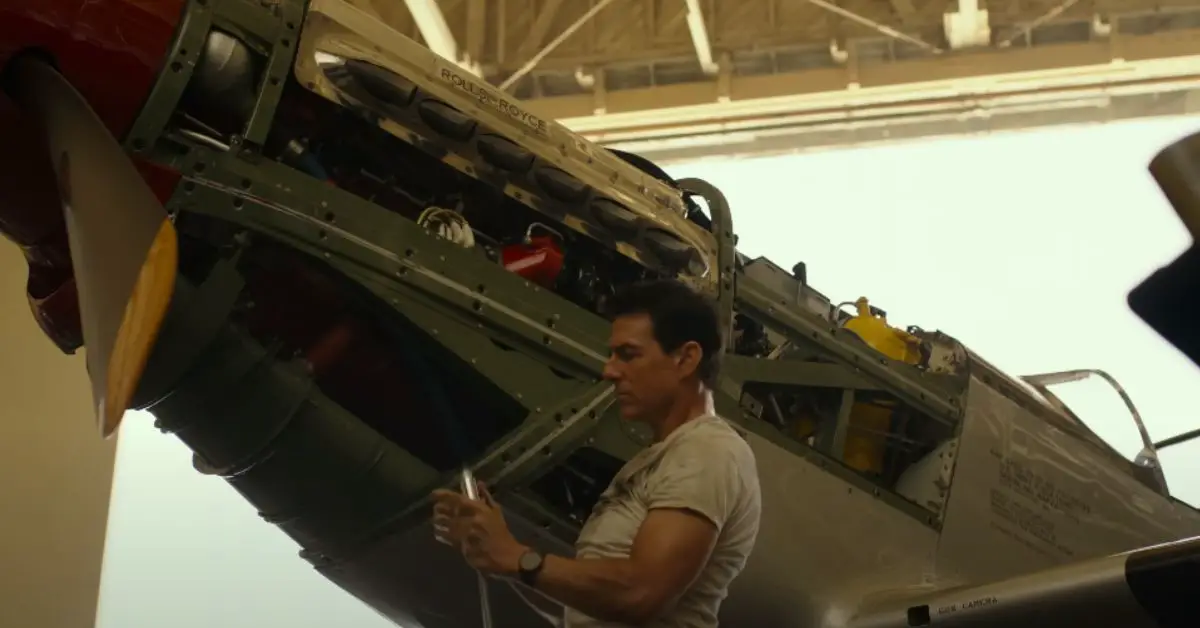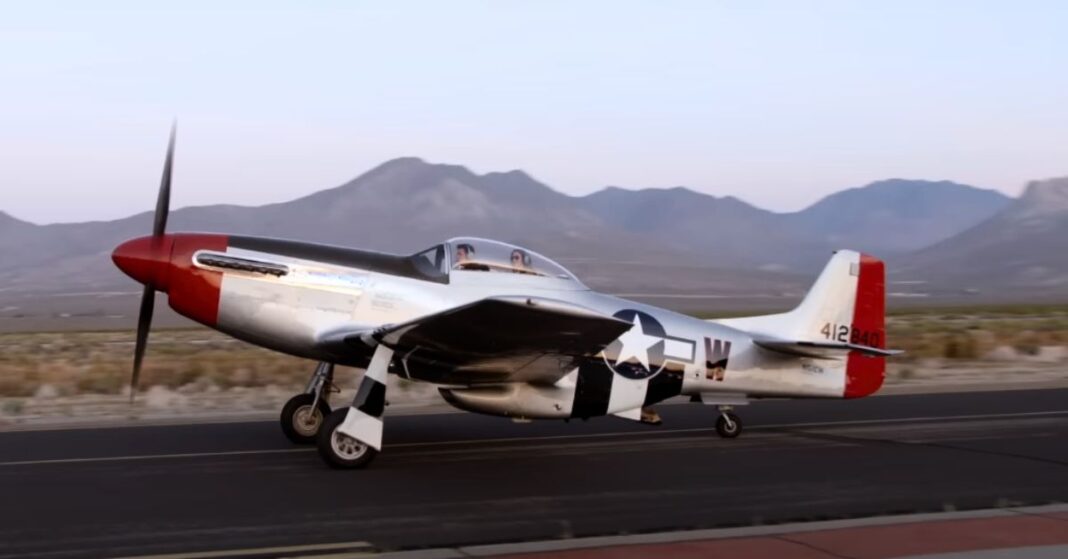Tom Cruise, an illustrious name in Hollywood, is not just acclaimed for his acting prowess but is also recognized for his passion for aviation.
Famously known for performing his airborne stunts in box office hits like Top Gun and Mission Impossible, Cruise’s fascination with the skies traverses beyond celluloid, as he is a certified pilot and an avid aircraft collector.
As intriguing as his films are Tom’s flying adventures and choice of aircraft. The P-51 Mustang stands out among these, an iconic fighter jet with a rich history dating back to World War II and the era of the Korean War.
Table of Contents
Does Tom Cruise own a P-51?
Yes, Tom Cruise indeed owns a noteworthy P-51 Mustang, and it’s not just any P-51 – it’s a stunning 1946 model that he reportedly acquired in 2001 for an estimated $4 million.
Cruise’s well-documented passion for aviation is underscored by his ownership of this iconic World War II fighter plane. The fact that he piloted his P-51 in the climactic scene of the 2022 movie “Top Gun: Maverick” adds an extra layer of authenticity and personal touch to the already thrilling sequence.
Dubbed “Kiss Me Kate” after his ex-wife Katie Holmes, Cruise’s P-51 Mustang is a formidable and graceful machine. It boasts a V-12 engine capable of generating up to 1,600 horsepower, reaching a top speed of over 400 miles per hour.
Given Cruise’s status as a licensed pilot with extensive experience in various aircraft, it’s hardly surprising that he handles this powerful plane with apparent ease.
How much was Tom Cruise’s P-51 Mustang?
When Tom Cruise purchased his P-51 Mustang in 2001, the stunning 1946 model reportedly set him back around $4 million.
What engine is in Tom Cruise P-51 Mustang?
Tom Cruise’s P-51 Mustang takes flight with either a Rolls-Royce Merlin 66 or a Packard V-1650-7, powerful V-12 engines boasting 1,690 and 1,490 horsepower, respectively. The Merlin, a British hero from WWII, excels at high altitudes, propelling the plane to speeds exceeding 400 mph.
On the other hand, the American-made Packard, a licensed cousin of the Merlin, offers similar performance, making it a robust choice for the P-51.
While the specific engine in Cruise’s Mustang remains undisclosed, both the Merlin 66 and Packard V-1650-7 contributed to the legendary status of the P-51 Mustang, serving as hidden powerhouses beneath its sleek exterior. Whether it’s the British bulldog or the American stallion, envision Cruise at the controls, soaring through the skies on thrilling adventures.

Related: Does Tom Cruise have a pilot’s license?
Tom Cruise’s Interest in Aviation
If Tom Cruise’s love for aviation were to be encapsulated in an aircraft, the P-51 Mustang might just be the perfect discourse. It not only mirrors his passion for flying but also his propensity for portraying indomitable characters on-screen. So, does Tom Cruise own a P-51 Mustang? The answer, born out of his lifelong passion for aviation, coupled with his love for adventure, is a soaring yes.
Right from an early age, Cruise was fascinated with planes and loved to gaze at the sky, dreaming of the feelings one could experience while soaring above the clouds. That dream came to fruition in 1994 when Cruise obtained his pilot’s license and became an accomplished aviator with a collection of aircraft to his name!
It’s intriguing to note that Cruise often incorporates his passion for aviation into his films. Who can forget the iconic scenes in ‘Top Gun,’ where the actor played a military pilot, demonstrating his amazing skills in the cockpit? What may surprise some fans is that many of these scenes involved actual flight sequences piloted by Cruise himself! Talk about dedication!
Further highlighting his love for the sky, Cruise is the proud owner of a Gulfstream IV, a luxurious twin-jet aircraft. Additionally, he possesses a vintage World War II Mustang P-51 fighter plane famously christened as ‘Kiss Me, Kate.’ This particular beauty is a testament to Cruise’s deep love for aviation history and his ability to preserve an integral piece of it.
When it comes to aviation training, Cruise leaves no stone unturned. Despite his busy acting schedule, he continually seeks to improve his piloting skills. He trains for advanced flight rules, enhancing his flight safety understanding, and learning more complex maneuvers. Even in his leisure time, the thrill of aviation seems to be his preferred distraction.
But beyond the actual flying, Cruise’s fascination with aviation extends to the support and growth of the aviation industry. In 2007, Cruise was honored with the 4th Annual “Living Legends of Aviation” award, cementing his contribution and enthusiasm towards aviation.
Indeed, Tom Cruise’s interest in aviation is an exciting exploration of the possibilities that lie in the world of hobbies. It shows how a childhood fascination can transform into a lifelong passion, and how that passion can shape one’s life, career, and even the world’s perception of them.
The P-51 Mustang and its History
The P-51 Mustang has a sterling reputation in the world of aviation and is an undisputed icon for various reasons. Introduced during World War II, the Mustang played a major role in securing Allied air superiority. It was renowned for its speed, range, and flexibility on combat missions, setting it apart from many other fighter planes of the era.
A standout feature of the P-51 Mustang was its advanced aerodynamics. With laminar flow wings, the aircraft drastically reduced air drag, enhancing its speed and performance. The Mustang could achieve a speed exceeding 430 miles per hour – a remarkable feat for a fighter plane in that period.
Another game-changing aspect was its range. The Mustang could fly about 1,900 miles without refueling, thanks to the design of its wing tanks and the drop tanks that could be jettisoned when empty. This extended range allowed the Mustang to escort bombers to their destinations, protecting them from enemy aircraft, which was a significant advantage that turned the tide of war in favor of the Allies.
Beyond its technical features, the P-51 Mustang was also admired for its aesthetic qualities. It had an elegantly streamlined fuselage and was often cloaked in shiny metal with artistic, bold nose art, making it a head-turner even on the ground. And when airborne, with the recognizable purr of its Rolls-Royce Merlin engine, the Mustang commanded attention and respect.
After the war, the P-51 Mustang continued to capture the fascination of aviation enthusiasts. Many were modified for air racing and set numerous speed records, earning a place in the National Air and Space Museum. It became a beloved character in films and literature, continually fueling the dreams of many to fly high in the skies.
Today, the Mustang P-51 remains a touchstone for aviation hobbyists. It’s a symbol of human innovation, power, and the spirit of adventure. Like the admired actor Tom Cruise, who acquired one of the vintage P-51 Mustangs that survived in flying condition, many individuals are drawn to this unique machine from a different era.
The Mustang’s blend of history, performance, and grace has immortalized it as a legend in the aviation community. Its influence extends well beyond its service years, contributing to the cultural fabric of the world. Indeed, the P-51 Mustang is more than an aircraft; it is a testament to humanity’s aspiration to conquer the skies.





